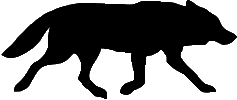Biology
Within the species
The wolf could not express its sociality without the complex ability of conveying information to other individuals, which is necessary for all the activities that fall within the normal biological cycle of the species; such activities happen both within the pack (such as the upbringing of the pups, the bond of the group during the hunt, the definition of the roles) and with other “foreign” conspecifics, solitary wolves or close packs, to defend their territory or to search a partner.
Communication with other wolves, called “intraspecific”, occurs through many signals that can be ascribable to three different types, according to their characteristics: visual, olfactory and odorous.
Among the visual signs, which we easily recognize even in dogs, there are for example the position of the tail, the ears, the head and the posture of the body as a whole: they generally relate to social rank and emotions. The odorous signals are connected instead to the production of chemical molecules by specific glands.
An example is the secretion of the perianal glands, which is deposited together with the faeces and contains information about the individual who produced it, such as sex, social status or reproductive status.
Communication also occurs at last through acoustic signals, the most famous of which is the howling, but there are also whimpers, whines, barks. The howls in particular can reach distances of several hundred metres, and can have different meanings, such as the reunification of different wolves of a pack, the position of the pack and its consistency, and the defence of the territory.
History
Bad for culture
Unlike in the previous ages, in which the wolf had a positive value, as for example for the ancient Romans, a warrior people who identified with the wolf, in the Middle Ages, when most of the population was devoted to agricultural activities, pastoralism had quite an important role in the rural economy, so there was in Europe a widespread negative opinion about the wolf, potential predator of the flocks.
From the time of Charlemagne, the figure of the so-called “luparo” was set as a professional hunter who hunted and eliminated what was considered to be the most ferocious and dangerous predator. For the protection they offered to the community, wolf-hunters were lavishly rewarded, by the institutions or by the population, among which they enjoyed a good reputation. The wolves were captured with lassos, trappings and ditches dug in the ground, poisoned or killed by the typical “lupara”, a shotgun loaded with pellets, and the puppies found in the dens were taken and left to die of starvation.
This figure survived in Italy until the last century, when in many areas of the peninsula together with the last wolf specimens their hunters officially disappeared and the wolf was declared protected species. As evidence of the bad reputation the wolf had in our Italian culture and of the beliefs rooted amongst the population, we still have the covers of the magazine “La Domenica del Corriere” from the early 1900s, which portrayed, by the way, improbable assaults on man by hoards of ravenous wolves. Actually there have been no attacks on humans around the last two centuries.
Curiosity
The role of the media
Even if the correct scientific information can be accessible to the public, the information reported by the media is often distorted for different purposes, and is not quite in line with reality.
It seems that the news, rather than understanding what really happens, are used to arouse strong emotions and reinforce ideological positions both for and against the wolf. Even the terms themselves used in articles, blogs and petitions influence the perception of public opinion:
the wolf is “scary”, is a “murderer” on the one side, or “victim to save” on the other side.
Furthermore, the monitoring projects of the already present wolf population have been interpreted as “repopulation” projects, suggesting that the specimens have been actively reintroduced into the wild. There is here high risk of inflaming the debate without a scientific and rational basis, and of creating erroneous beliefs amongst the society as well, which are difficult to eradicate.
